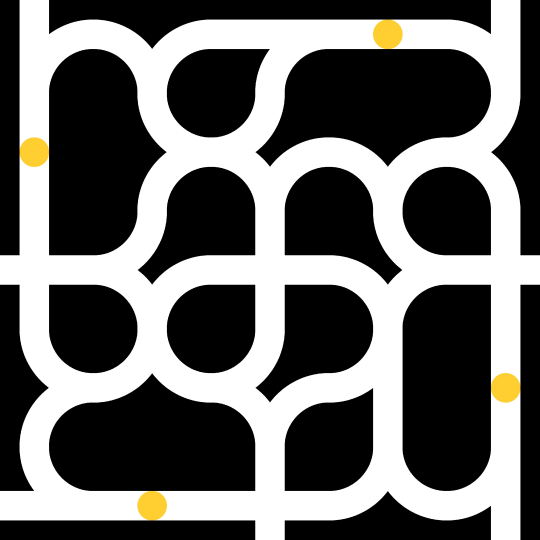Reviews
by Robert Abbott
|
Review posted September 25, 2009: 
The Zen of the Labyrinthby Dave PhillipsPaperback, 224 pages, $12.95
|
|
Try to ignore that title. Book publishers like to be clever and come up with names like that, even when the names don’t mean anything. That sort of nonsense is usually not the fault of the authors. Because the title will undoubtedly keep people from buying the book, I will, as a public service, point out that this is a very good book of mazes, and I recommend it. Many of you may remember Dave Phillips from his books published by Dover during the 1980s and 90s. These contained very complex mazes, though they all had the same general set of rules. Phillips has now branched out. His new book has eight different sets of rules and there are twenty mazes for each set. Furthermore, his mazes are now in full color, and they look great. If you saw some of these mazes hanging in a gallery, you might think they were examples of various schools of modern art. The best way to see what the book is like is to try the two examples shown below. |

|
This is Color Path 3, the third maze in the Color Path set of rules. Enter by the bottom red path and end on the center gray square. You may retrace your path but may not make a U-turn on a pathway. You must follow the paths in the order red, blue, yellow and then red, blue, yellow again, as needed, changing color on the white squares. |

|
This is Flow 9, from the Flow set of rules. Enter the maze through any of the available entrances, pass through all yellow circles, and then exit the maze. You may retrace your paths. Your course must follow the flow—no sharp turns (a sharp turn is anything that is 90° or more). Example: you must pass straight through an intersection of two paths that form a cross; a turn at such an intersection would be 90° and therefore illegal. |
|
Review posted February 2, 2007: I just read an intriguing book. It has nothing to do with mazes, but I can’t help reviewing it here. It is Born Fighting: How the Actually, a lot of people are Scotch-Irish and don’t know it. I was one of them. I used to think I was a WASP (and an intellectual) until my sister started to do genealogy and found we were descended from Appalachian rednecks. There is some interesting word derivation here. Redneck is an old term for Scotch-Irish and it originally meant Presbyterian, their religion when they left Scotland. Another term is cracker, which comes from cracken, a Scots dialect word meaning to speak (as in “He cracked a joke”). Webb relates the history of this group starting in the Borderlands between Scotland and England, where they spent centuries fighting the English. Braveheart was one of the leaders during that time. The basic difference between the English and the Scots was the English were a feudal society, organized from the top down. The Scots had the basic Celtic bottom-up organization. One’s allegiance was to the family or to the clan, not to any lord. We left that miserable area of Scotland and went to Northern Ireland for a couple of generations. Unfortunately we didn’t get along with our fellow Celts, the Irish, because they were Catholic. And we didn’t get along with our fellow Protestants, the English, because they were Anglican—an entirely different form of Protestantism. So next we went to America. In America we didn’t get along with: the Puritans in Massachusetts with their established Congregational church, the Pennsylvanians with their established Quaker church, the English planters in tidewater Virginia with their established Anglican (Episcopal) church. Webb notes that a lot of groups went to America for freedom of religion, but what they really wanted was freedom for just their religion. So they all had established churches. Thomas Jefferson was one of the English planters, but he worked to get a bill through the Virginia legislature to end the establishment of their church. Today, we don’t realize what a radical move that was. The Scotch-Irish finally settled in Appalachia, where they thrived, and when the rest of the country opened up, they were mostly the ones who settled it. Because the Scotch-Irish wouldn’t take crap from anyone—English invaders, government officials, priests (both Catholic and Anglican)—they gave America its greatest characteristic: a love of freedom. Today we think everyone has a love of freedom, but it’s actually pretty rare. In spite of his focus on the Scotch-Irish, Webb’s book provides an excellent history of America and especially of the South. It also has interesting military history. He answers a question I’ve always had: Why are the Celts, who are fierce fighters, always getting their asses kicked by people like the Romans, the Germans, and the English? The book also has extensive political discussions. The hardcover edition of Born Fighting was published in 2004. In 2006, James Webb, running as a Democrat, won the election for U.S. Senator from Virginia. This was the last election settled that year and it tipped the Senate to the Democrats. In my opinion, Webb is now the best mind in the Senate (of course, that isn’t saying much). More importantly, from what I see in Born Fighting, Webb is an economic conservative. Most of us economic conservatives think that the two Bush presidents were a disaster for the country and for the Republican party. But there is a glimmer of hope for us because, in addition to Webb, there are other economic conservatives in the Democratic party (generally known as Blue Dog Democrats). We can only hope they will develop into a more effective force. (Or maybe not—Webb gave the Democrats’ response to the State of the Union and it was nothing you could call conservative.) Here are two other views of this book: one from the Weekly Standard (pretty funny) and one from Reason Magazine. Back to the home page |

|